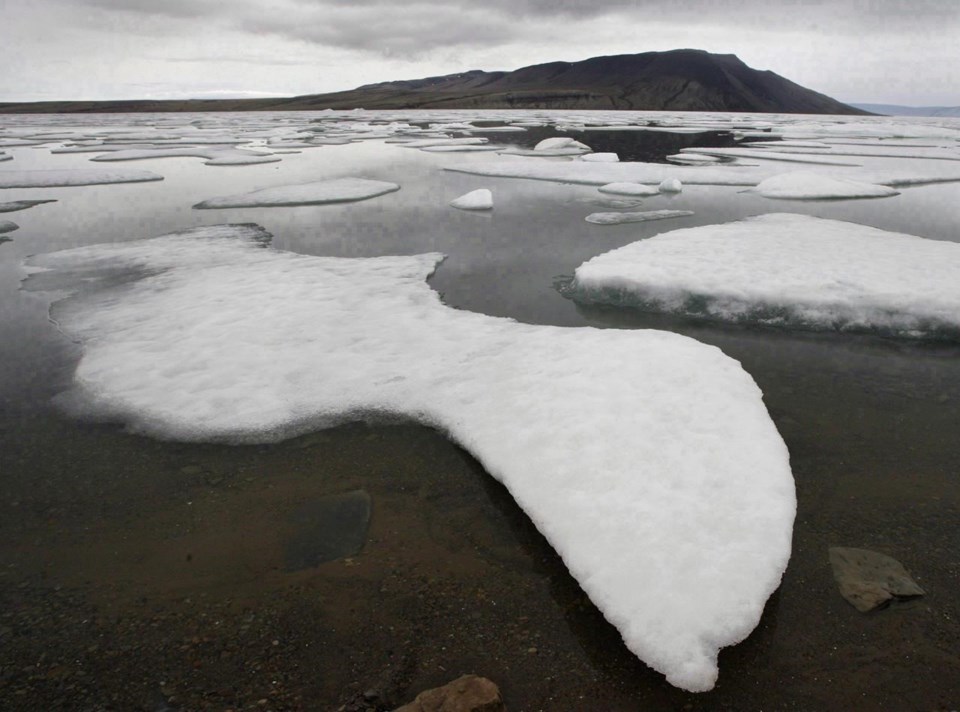YELLOWKNIFE — While the Arctic is better known for blankets of snow than rain clouds, new research suggests the number of rainy days in the region will roughly double by the end of this century.
The study, published in the American Geophysical Union journal Earth's Future, used climate modelling to predict changes in precipitation under a high level of greenhouse gas emissions from 2015 to 2100. It found that not only will there be more rainfall in the Arctic by 2100, it will occur earlier in the spring and expand further toward the center of the Arctic Ocean and inland Greenland.Â
Lead author Tingfeng Dou, a climate scientist at the University of Chinese Academy of Sciences, said this will mean "the arrival of a new Arctic."Â
“In the past, rainfall was primarily limited to the edges of the Greenland ice sheet,” he said in a press release.Â
The study's authors, researchers from China and the Netherlands, said more frequent and intense rainfall in the Arctic is expected to increase permafrost melt, releasing large amounts of greenhouse gases, as well as reduce snow cover, and speed up sea-ice loss.
They said it's also anticipated to result in more rain-on-snow events, where rain falls on existing snowpack and freezes, resulting in an icy crust on top of or within the snow. That can have serious consequences for foraging animals like reindeer, as their food is trapped under the ice, and socio-economic impacts for people who rely on them for food, clothing, transportation and cultural practices.
“Even ordinary rainfall can be regarded as an extreme event in polar regions,” Dou said.
Mark Serreze, director of the National Snow and Ice Data Center with the University of Colorado Boulder, who was not involved in the recent study, researches rain-on-snow events and their impact on human environment systems like reindeer herding. He said there have been cases where tens of thousands of reindeer and muskox have died because they couldn't forage following rainfall.Â
"The impacts can extend through generations," he said, noting it can lead to increased calf mortality. "These are pretty big effects and the real concern is that we will see more of these as the climate change occurs."
Serreze said that in a warmer environment, the atmosphere can carry more water vapour, resulting in more precipitation. A warmer climate also results in more rain than snow.Â
The study found the predicted precipitation changes are largely due to rapid warming in the Arctic, which is heating up three times faster than the global average. The increase in total precipitation was also a contributing factor.
Other scientists agree the Arctic will become wetter in the 21st century.
Michelle McCrystall is a post-doctoral researcher with the University of Manitoba's Centre for Earth Observation Science. She was the lead author of a study published last November, which predicted the Arctic could see more rain than snow as soon as 2050, decades earlier than previously thought.
McCrystall said data from weather stations indicates the region is already seeing the transition to less snow and more rain.
"What really astounded us was kind of the rate at which change happens," she said.
McCrystall said other potential impacts from the shift to a rainier Arctic include changes in ocean circulation and sea levels due to an influx of fresh water, and an increase in phytoplankton as sea-ice warms. She said changes in the Arctic could also affect the climate at lower latitudes, pointing to a 2018 snowstorm across much of Europe, dubbed the "Beast from the East," which was caused by the loss of ice in the Barents Sea.Â
"There is very much local-scale changes happening, but it can affect the Northern Hemisphere climate as well."
This report by The Canadian Press was first published Oct. 8, 2022.
___
This story was produced with the financial assistance of the Meta and Canadian Press News Fellowship.
Emily Blake, The Canadian Press




